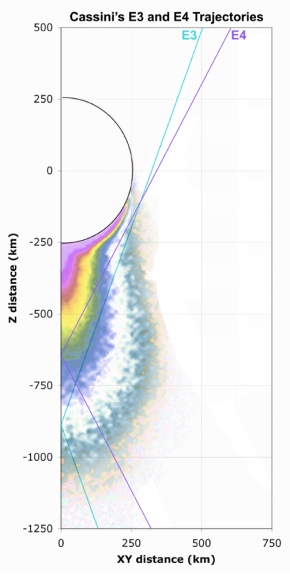Although the Cassini spacecraft has just passed no more than fifty kilometers from the surface of Saturn’s moon Enceladus, the investigation of the intriguing object will only intensify in October, when Cassini moves to within half that distance. With astrobiological interest high, Enceladus is a hot place to be. Data from the most recent flyby began streaming in to the Deep Space Network station in Canberra last night, with the downlink scheduled to continue into the afternoon of the 12th (EST).

The prime target, using every camera resource available and covering infrared, visible light and ultraviolet, is the area of the moon’s southern pole that houses the fissures now known as ‘tiger stripes.’ Under intense scrutiny will be the terrain of the fissures as well as the composition of the ice grains inside, and tuning up our data on temperature should provide a better idea of whether or not liquid water lies close to the surface. Cassini will be looking for other elements — oxygen, hydrogen or organics — mixing with the ice. “Knowing the sizes of the particles, their rates and what else is mixed in these jets,” says ultraviolet imaging spectrograph team member Amanda Hendrix, “can tell us a lot about what’s happening inside the little moon.”
Image: This graphic shows the trajectory (E4) for the Cassini spacecraft during its flyby of the icy moon Enceladus on Aug. 11, 2008, along with the trajectory of its earlier March encounter (E3). At closest approach, Cassini was 50 kilometers (30 miles) from the surface. The spacecraft’s optical remote sensing instruments imaged the fissures running across the moon’s south pole, where the icy jets originate. Credit: NASA/JPL.
We know, of course, that plenty is happening to cause the geysers of water ice and vapor that stream out of the fissures and feed Saturn’s E-ring with material. The raw images from the encounter are showing up on the JPL server, worth a look if you enjoy watching the early results of a flyby unfold (the best should be available in the early evening EST). And keep an eye on the tiger stripe known as Damascus Sulcus. Just before the flyby, John Spencer, who works on the Composite Infrared Spectrometer team that maps heat radiation from the tiger stripes, said he was anxious to see how this close pass pays off in terms of detail:
I’m most excited about the observation we’ll be attempting at about 21:11 UT, when we will try to put the CIRS short-wavelength detector right along one of the most active tiger stripes, called Damascus Sulcus, from a distance of only 4,500 km (2,800 miles). On our last flyby we saw temperatures as high as at least 180 Kelvin (-135 Fahrenheit) on this part of Damascus, from 15,000 km (9,000 mile) range, and from three times closer we might see even higher temperatures because the warm material, which we think occupies a strip just tens or hundreds of meters wide along the fractures, will fill more of our detector and give us a more accurate reading. However, this is a challenging observation because our detector consists of a linear array of ten pixels, which will be aligned parallel to the fracture. Pointing may not be perfect this close to the moon, so we may get all ten detectors, or none of them, on Damascus.
Poking around in places like the Enceladus flyby blog (from which I drew Spencer’s observation) is a lively practice when things are jumping with the spacecraft, as they are now. And we’ll see, in coming days and weeks, how the incoming temperature data back up the theory that liquid water exists somewhere within the moon.


Hi Dad2059 and Paul;
Although this thread has not received many comments so far, I nonetheless feel that it is one of the most important threads for short term consideration’s sake although all Centauri Dreams threads are worthy and important. Manned exploration of our solar systems moons I think can get a real jump start from developments like the VASIMR Engine.
The number of Moons within our solar system is rather phenomenal, and accordingly to a website published in 2006, the tally stands as follows:
Planet Number of Moons:
Mercury 0
Venus 0
Earth 1
Mars 2
Jupiter 63
Saturn 60
Uranus 27
Neptune 13
Pluto 3
Many of these Moons are at least as large in diameter as Earth’s Moon and so with all of NASAs ability to design and send robotic probes. I can see great opportunity to do basic planetary science in the coming decades as well as manned expeditions to these moons. The knowledge we will gain from such will be helpful in modeling and observing extra solar worlds eventually leading to manned expeditions to them.
Thanks;
Your Friend Jim